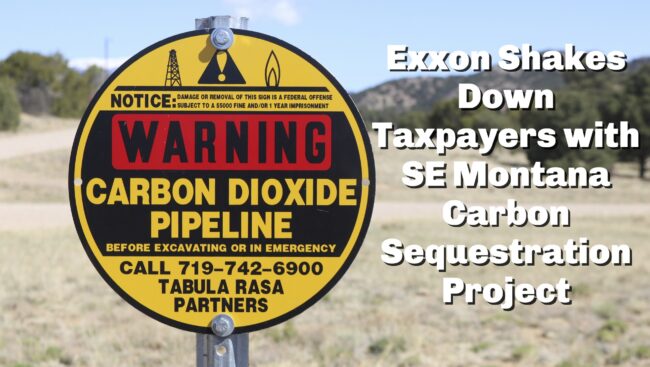
By Nick Fitzmaurice
Since issuing its geologic carbon storage policy for public lands in 2022, the Bureau of Land Management (BLM) has only received applications for two proposed carbon sequestration projects on BLM lands: one in southwest Wyoming and a second in southeast Montana with the theoretical combined potential to sequester upwards of 200 million tons of CO2 over the 20-year lifetime of the projects. However, ExxonMobil Corporation (and its subsidiary Denbury Inc.) submitted both of these proposals and intends to cash out on federal carbon sequestration tax credits by simply moving CO2 from one geologic formation to another without actually mitigating the climate harms of CO2 emissions as the tax credit is intended. At $85 per ton of CO2, Exxon could theoretically rake in up to $17 billion in federal tax dollars from these two projects.
The project in Montana is the larger of the two, with CO2 sourced primarily from ExxonMobil’s Shute Creek gas processing plant in Wyoming, along with supplemental gas from Wyoming’s Lost Cabin gas processing plant. CO2 captured at these gas processing facilities is pulled directly from the ground and would not be entering the atmosphere if not for the operations at and upstream of these facilities. Specifically, the Shute Creek Treating Facility (SCTF) processes gas that is primarily CO2, not methane. In fact, this is the lowest methane-content fossil gas that is commercially processed for methane anywhere in the world, only made economically viable when there is a secondary market for the CO2 removed from the gas. Historically, that CO2 has been sold for Enhanced Oil Recovery (EOR) where it is injected into active oil wells to produce more climate-damaging fuels (with unsold CO2 vented directly into the atmosphere). With diminishing EOR markets, Exxon is now seeking a lifeline in these carbon sequestration tax credits.
SCTF was originally built with carbon capture technology, but over its lifetime it has vented approximately 50% of processed CO2 directly into the atmosphere, totaling over 130 million tons of CO2 emissions as of 2022. In the best-case sequestration scenario, SCTF capture technology would still emit about 2.5 million tons of CO2 annually, or 50 million tons of CO2 over the 20-year lifetime of Denbury’s sequestration project. This excludes other emission sources upstream and downstream of SCTF, such as CO2, methane, or other greenhouse gases leaking in gas extraction, gas transportation to SCTF, CO2 pipeline transportation, or long-term leakage from the geologic storage site. Denbury’s sequestration project enables and guarantees the continuation of all of these emissions sources.
To perform its exploitative maneuver, Exxon must transport compressed CO2 through pipelines more than 500 miles over land from its extraction site to the proposed injection wells in Montana. This poses tremendous safety risks as pipelines are prone to undetected leaks. Because isolated CO2 is heavier than ambient air, CO2 from pipeline leaks accumulates in valleys and depressions, creating the danger of asphyxiation and death in these locations. CO2 pipelines already used for EOR in Montana have been known to rupture explosively, leaving craters on public and private land. Many landowners near existing and proposed CO2 pipelines in eastern Montana are extremely concerned about the risks of pipeline ruptures. One rancher filed a legal complaint against Denbury in 2023 citing the mismanagement of CO2 pipelines that caused 16 identified leaks and ruptures on his land over the course of a decade. A CO2 pipeline operated by Denbury in Mississippi ruptured in 2020 near a rural town, leading to hundreds of evacuations and nearly 50 hospitalizations.
Rather than energy-intensively capturing and sequestering some of the CO2 at these facilities, Exxon could instead thoughtfully plan for their decommissioning, replacing the energy production with cleaner, more cost-effective resources that embody a higher energy return on investment (the amount of energy produced weighed against the amount consumed in its production). Exxon could cease operation at the Shute Creek gas processing facility, saving taxpayers up to $17 billion dollars and directly mitigating the nearly 200 million tons of CO2 that would be processed at this facility over the projected 20-year lifetime of the proposed sequestration project.
This article was published in the July 2024 issue of Down To Earth.

